SECTION K: Tectonic Processes and Landforms
1/125
There's no tags or description
Looks like no tags are added yet.
Name | Mastery | Learn | Test | Matching | Spaced |
|---|
No study sessions yet.
126 Terms
Plate
Large, rigid slab of solid rocks
They move, either slide under or go together
Tectonics
Greek origins: to build
What is the theory of plate tectonics?
Considers the earths crust & upper mantle to be composed of several large, thin, relatively rigid plates that move relative to one another as they ride atop the hotter, more mobile material (asthenosphere)
Is this theory supported?
YES, by a wide range of evidence
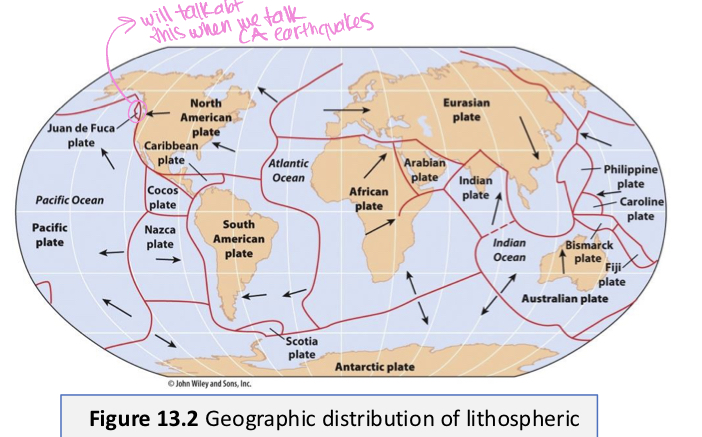
When we talk about the plate tectonics we are referring to…
The lithosphere that float/ride on the hot sticky material in the asthenosphere
An important component of plate tectonics is..?
Continental drift
Continental drift?
Wegener’s theory of continental drift.
Proposes that continents were originally connected as 1 or 2 landmasses that have been broken up & drifted apart for several million years
What do we call these 1-2 landmasses that used to exist ?
Supercontinent PANGEA
Around 275 million years ago
Wegener’s theory is based on…
Matching :
Rocks & fossils
Mountain belts
Glacial evidence
Coastlines of S America and Africa
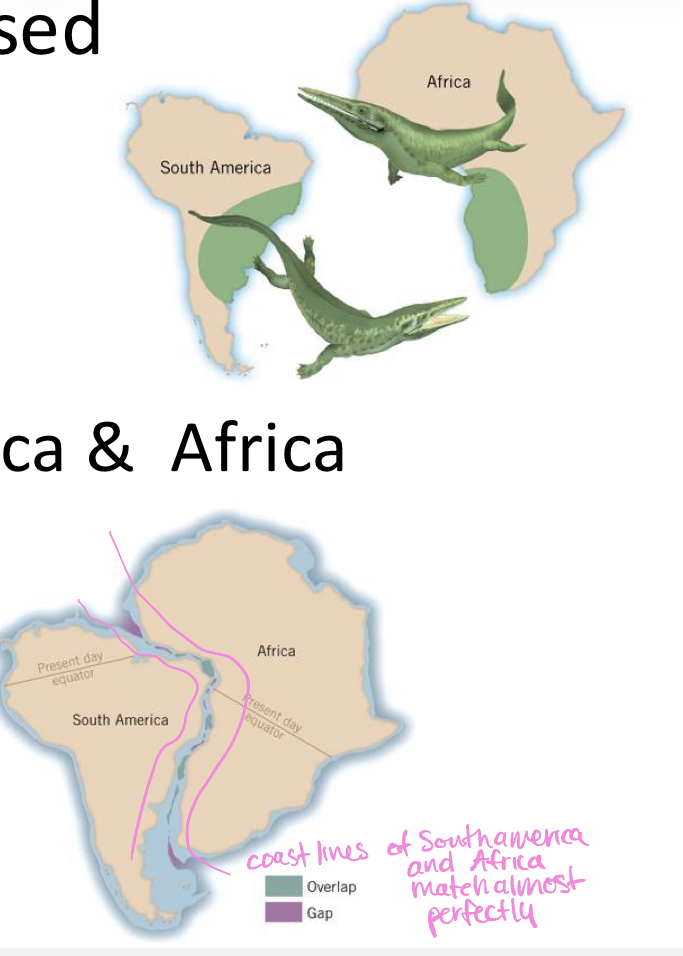
Did people accept Wegener’s theory ? Why?
NO
Because they thought the lithosphere was too rigid to move that much
And
Wegener didn’t know why/ couldnt explain how the continent could have moved that much
SO
The theory was rejected and he died on an expedition before ppl started accepting it
What are the 3 forms of evidence we have today for the plate tectonic theory?
1 — detailed map of the ocean floor
2 — plate boundaries
3 — sea floor spreading
—3A : Paleomagnetism
—3B : Ocean core sampling
Detailed map of the ocean floor was provided when and how?
After World War II
By bathymetric mapping, which provided evidence that led to development of theory of plate tectonics
In the 1950’s and 60s ____________ revealed?
Deep sea soundings via sonar revealed
Mid ocean ridges
Seamounts
Deep sea trenches
Mid-ocean ridges?
Areas in the oceanic crust where there’s new oceanic crust being created
Seamounts ?
Flat topped, old, eroded volcanoes that are underwater
Deep-sea trenches ?
Very deep in the ocean, maximum bottom of the ocean
The deepest one is Mariana’s trench
Plate boundaries contribute to…?
Evidence for plate tectonic theory (Wegener’s theory that was rejected)
What are plate boundaries ?
The boundary around each plate tectonic
Image of plates in relation to earthquakes (red dots)

Which plate boundaries have earthquakes ?
ALL PLATE BOUNDARIES including mid-ocean ridges
But some generate more earthquakes
The third evidence for plate tectonic theory?
Seafloor spreading !
Who/ when was the theory of sea floor spreading proposed? What is it supported by?
In 1960, Harry Hess proposed the idea of seafloor spreading which later developed into broader theory of plate tectonics
The theory is supported by two sets of evidence :
A — paleomagnetism
B — ocean core sampling / age of ocean floors
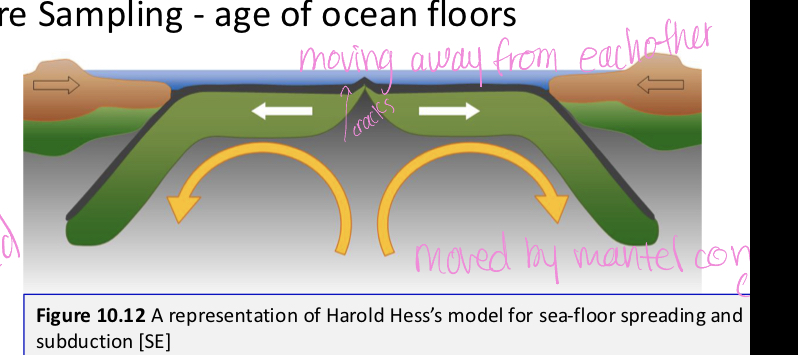
Paleomagnetism is
The first way to verify seafloor spreading:
Iron in cooled magma orients itself with the magnetic poles of earth
Provides a record of past magnetic fields
Magnetic field has changed orientation at least 170 times
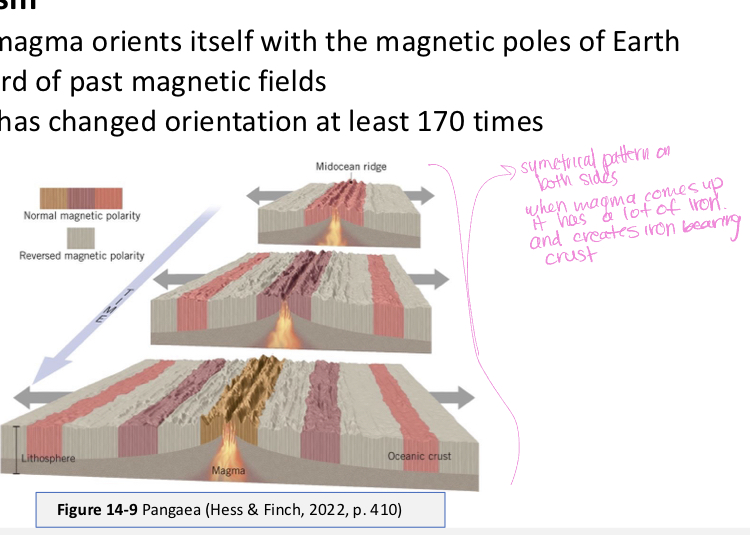
Ocean core sampling
The second way to verify seafloor spreading:
Youngest crust & thinnest accumulation of sediments at mid-ocean ridges
Oldest crust & thickest accumulation of sediments near continents
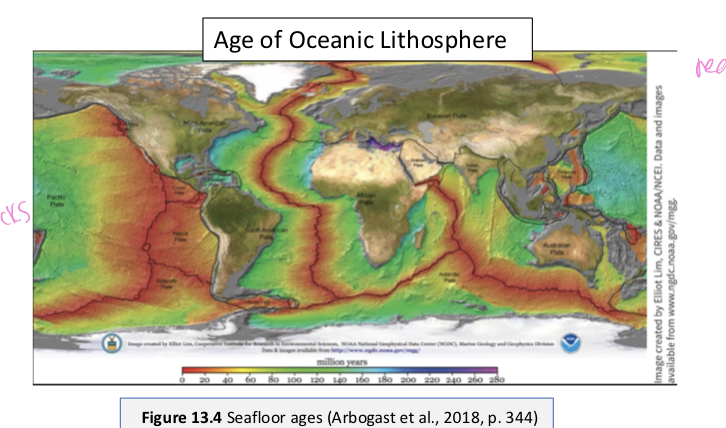
What moves plate tectonics ?
Plate tectonics “float” on the asthenosphere but move by convection loops meaning they are driven by earths internal heat.
Mantle (magma) plumes from the mantle rise to the crust, spread horizontally and cool, moving segments of the crust
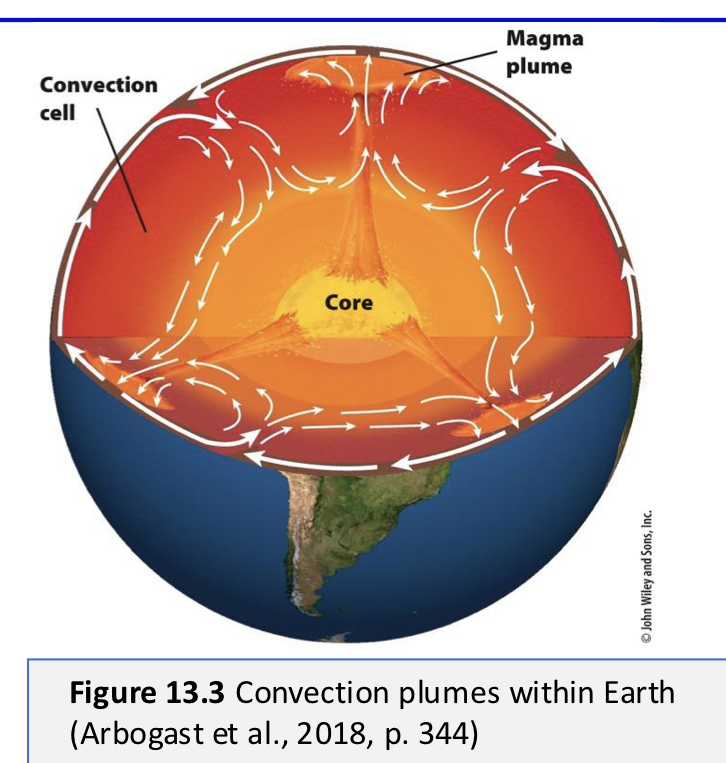
The model for tectonic plate movement consists of …
Seafloor spreading: oceanic ridges formed by currents of deep magma rising from the mantle which creates new crust on ridges
Subduction:
Older crust descends into earth (melted and recycled)
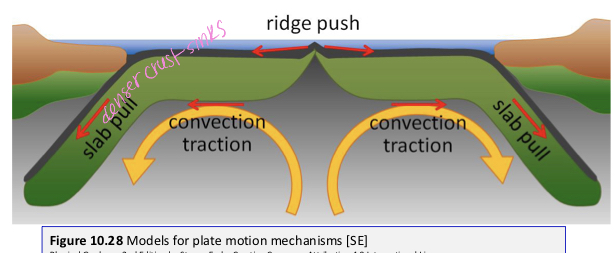
Which plate sinks during subduction ?
THE DENSER ONE
Plate boundaries overview (be able to draw this on paper)
Image:

When does plate divergence happen ?
Seafloor spreading (mid ocean ridges)
Rifting (rift valleys)

Types of plate convergence ?
Continent to ocean (subduction)
Ocean to ocean (subduction)
Continent to continent (minor subduction)
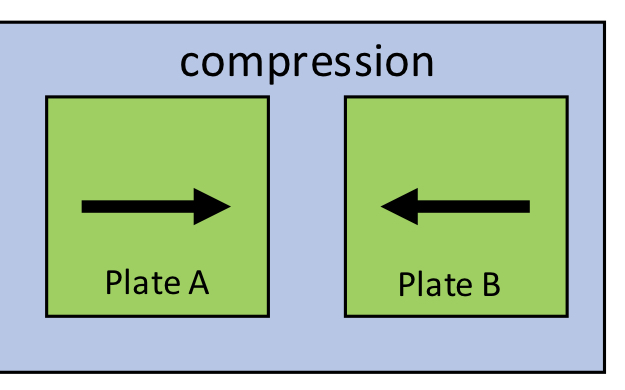
Where do transform plate margins occur ?
On sea floor : offsets in mid-ocean ridges
On land : San Andreas fault system
No subduction

First type of plate divergence
Seafloor spreading :
Creates mid-ocean ridges
Two plates move away from eachother on the ocean floor due to magma upwelling (mantle plume) from asthenosphere
The extrusion of magma creates ridge-like features on the seafloor
Seafloor spreading is a ________ plate boundary.
Constructive.
Because new rock is being created
Second kind of plate divergence
Rifting:
When two continental plates move away from eachother due to magma magma upwelling (magma plume) from asthenosphere
May cause gradual split in the landmass e.g. East African rift valley
What does rifting produce?
Produces distinct valley landscapes bordered by steep canyon walls
Then, lowlands can fill with water, forming lakes (lake victoria)
Effects of rifting (3)
Elevates region
Causes earthquakes, volcanic eruptions
Forms long mountain ranges separated by broad valleys
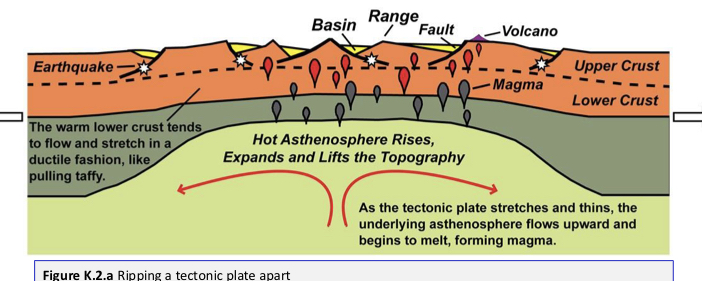
Transform plate margins are..?
Boundaries where plates slide horizontally past eachother
Plane of motion is along a nearly vertical break (or fault) that extends through much of the lithosphere
Example of transform plate boundary?
The San Andreas Fault System
North American & pacific plate
California magnitude 6-7 usually San Andreas
What type of boundary is a transform plate margin ?
Conservative
Because there’s no rock being created
Transform fault
Mid-Atlantic ridge
Seafloor spreading creates transform faults
1906 earthquake ?
San Francisco earthquake
700 people died and 30$ billion in damage
From the San Andreas fault system
1989 earthquake ?
Loam prieta earthquake
Also caused by San Andreas fault system
62 ppl died and 6$ billion in damage
In the next thirty years California has a ____ chance of a large earthquake bigger than magnitude 6.7
72% chance
Three types of plate convergence ?
Oceanic to continental crust
Oceanic crust to oceanic crust
Continental to continental crust (minor or NO subduction)
Ocean to continent plate convergence
Denser oceanic plate (3.0g/cm3) subducts beneath buoyant continental plate (2.7g/cm3)
Destructive boundary because rock is destroyed (subduction)
Subduction trenches form next to continents
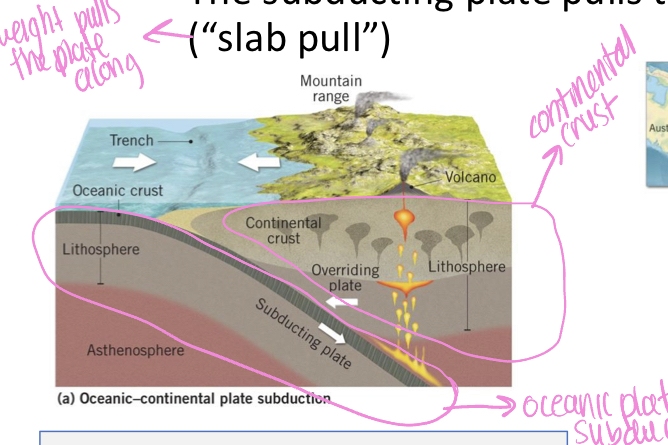
What is slab pull
The subducting plate pulls the rest down, causing movement
Ocean to continent convergent plate boundary can cause …
Composite volcanoes
Composite volcanoes
When magma rises, producing extrusive and intrusive igneous rocks
Continental volcanic arc
E.g. cascades (North America), Andes mountains (South America)
Created when a plate going down so theres stuff coming up onto land
Which earthquakes are caused by ocean to continent convergence plate boundaries ?
Both shallow and deep earthquakes (due to subduction)
Can be as deep as 600km below surface
Ocean-to-ocean convergent plate boundaries
Both plates have similar densities but the denser one subducts
Features of Ocean-to-ocean convergent plate boundaries
Deep ocean trench
Deep and shallow earthquakes
Volcanic island arcs:
e.g. Aleutian Islands (near Alaska), japan, and Mariana islands (western North Pacific )
Destructive boundary because rock is destroyed, associated with subduction
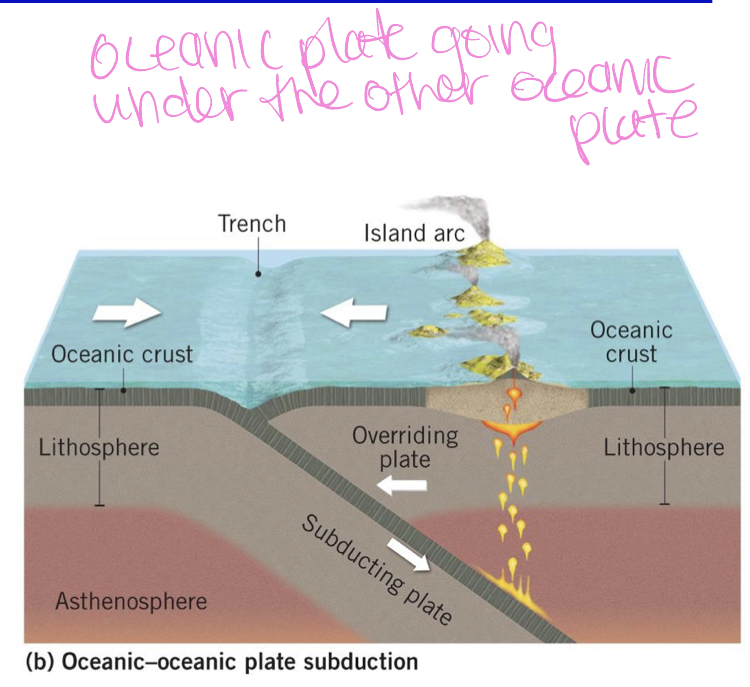
Continent to continent plate boundary
2 converging continental plates of similar density
Minimal subduction occurs because too buoyant so they crash and crumble
No subduction means no deep earthquakes
Mountains are created
Conservative boundary : rock is neither created nor destroyed
Orogeny
A distinct period of mountain building
Compression (plate convergence) can create mountains
Terrane
A piece of lithosphere that is added to a continental plate
The west coast mosaic of terranes
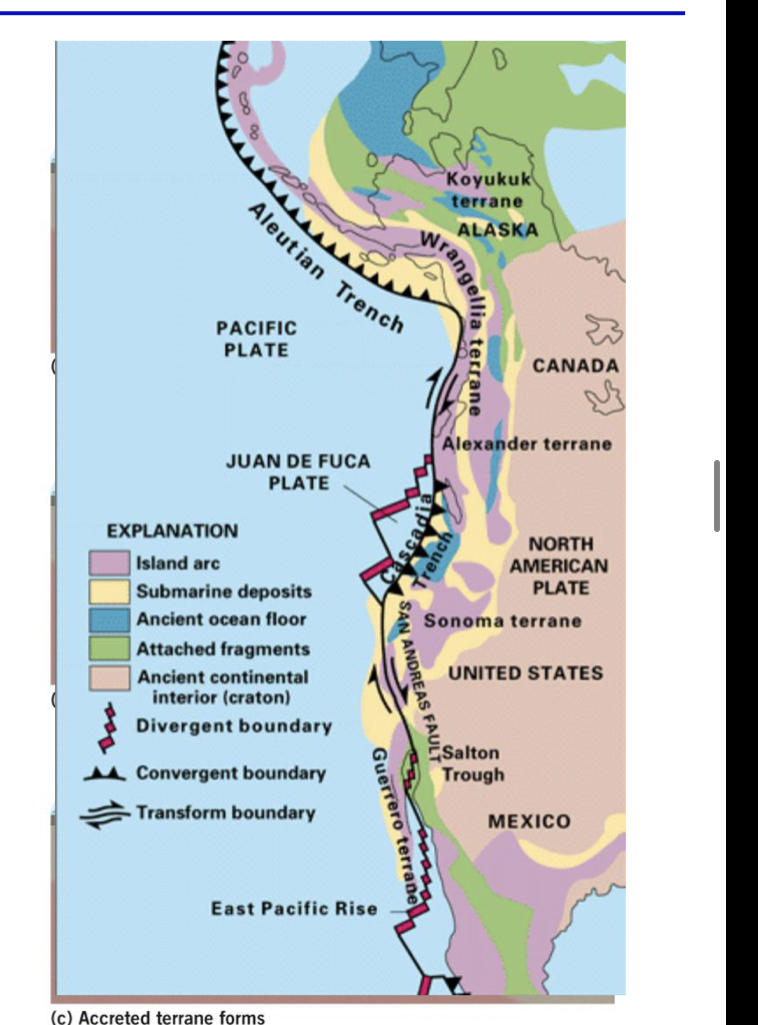
Summary of plate boundaries (photo)
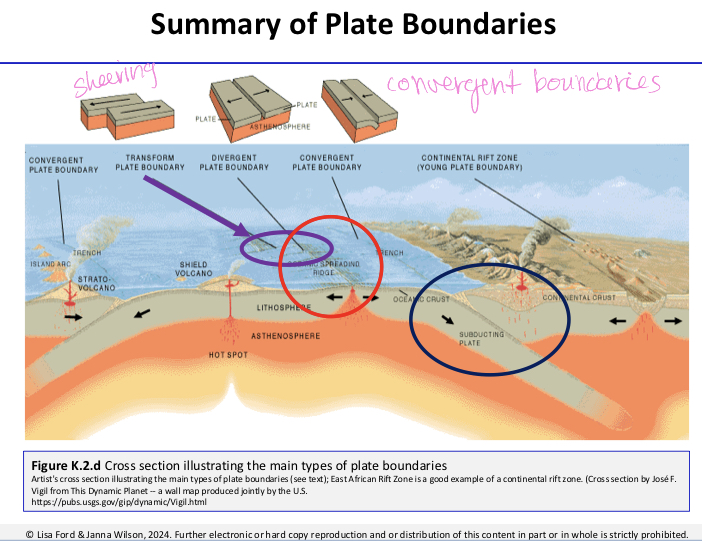
Earthquakes are
A sudden release of accumulated tectonic stress results in an instantaneous movement of the earths crust
Seismic waves radiate through the lithosphere
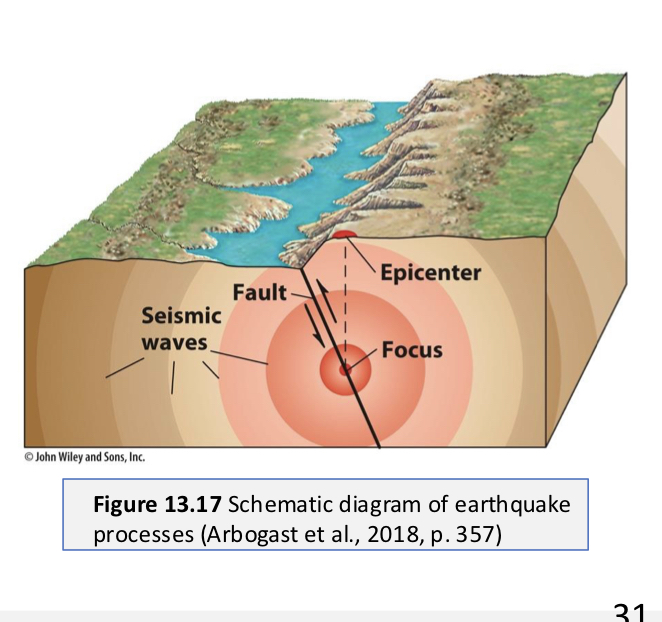
Joint ?
A crack no movement
Fault ?
Crack in the earths crust that results in the vertical &/or horizontal displacement of one rock body relative to another
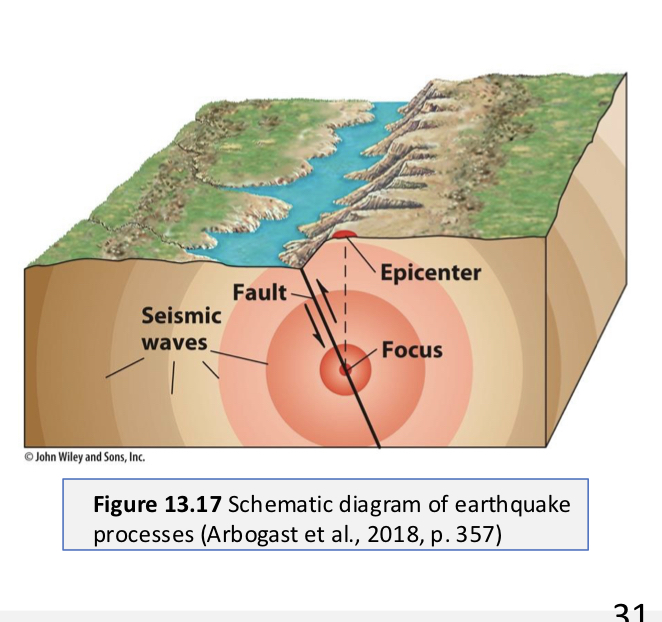
Focus ?
The placed in the lithosphere where the fault breaks
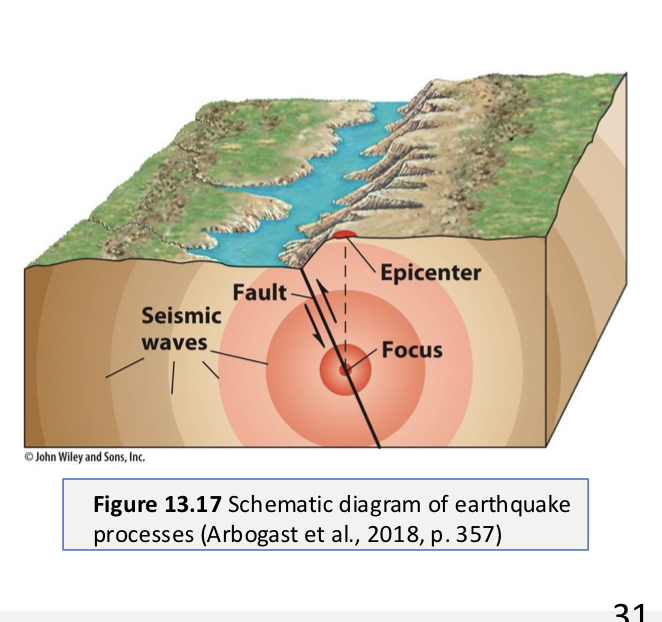
Epicentre ?
Point directly above the focus
On the surface, normally where the most damage happens
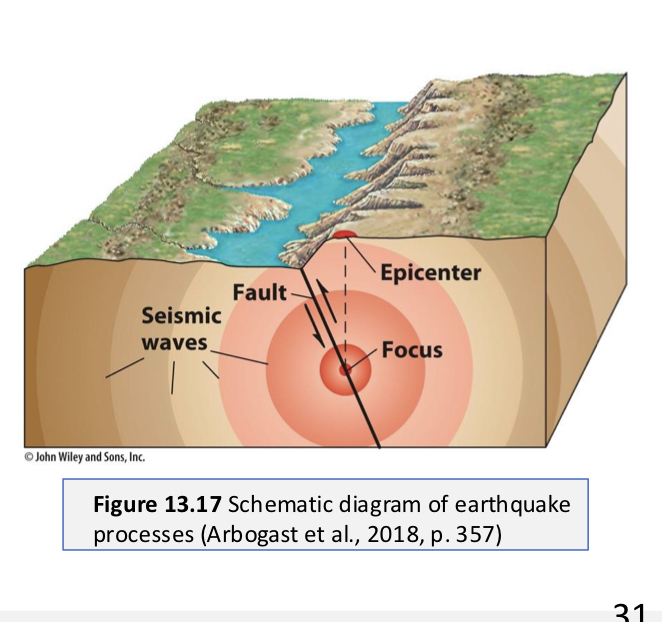
How do earthquake waves move?
Body waves : Move through the interior of the earth
P waves (primary): fastest moving waves compress/relax
S waves (secondary): slower moving, side to side and up-and-down “shearing” motion
AND
Surface waves : only travel across the surface, slower than S waves
Some side-to-side, rolling action, different ones move differently

What is one way to measure earthquake magnitude?
Richter scale
Richter scale is a measurement of ?
Measurement of energy released during an earthquake, compares relative “size” of earthquakes
Richter scale accuracy and development ?
Developed in 1935 by Charles richter
Only accurate to about 7 magnitude
What type of scale is the Richter scale?
Logarithmic scale : 0-9
Related to the amplitude of seismic waves on a seismograph
Each whole number represents →
around 32x increase in energy released
10x increase in wave amplitude
Another way to measure earthquakes
Moment magnitude : an accurate measurement of the energy released as rock moves at a fault
How is moment magnitude calculated ?
Area ruptured along the fault plane
Slip (amount of movement or slippage along the fault)
Rigidity (which is a studied, known value) of rocks near the focus
More accurate above 7.0 earthquakes
What type of relationship does magnitude and frequency have
Inverse relationship
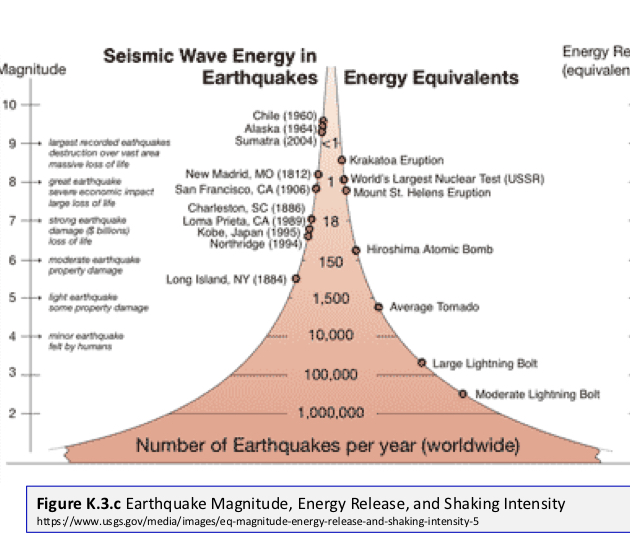
Types of earthquake faults
Normal fault
Reverse fault
Strike-slip fault
Overthrust fault
Normal fault
Tension / extension : blocks of land moving away from eachother
Verticale displacement
Reverse fault
Collision / compression : land pushing together
Vertical displacement
Strike-slip fault
Shearing (side-by-side) displacement is horizontal : no tsunamis at strike-slip because tsunamis need vertical displacement
Overthrust fault
Compression: vertical and horizontal displacement, often associated with subduction
Fault zone
Weakness in crust
Fault scarp
Steep cliff formed by faulting
Horst
“Horstin’ it up!”
An upthrown block that lies between two steeply inclined fault blocks
Graben
“Graben it down”
A downthrown block that lies between two steeply-inclined fault blocks
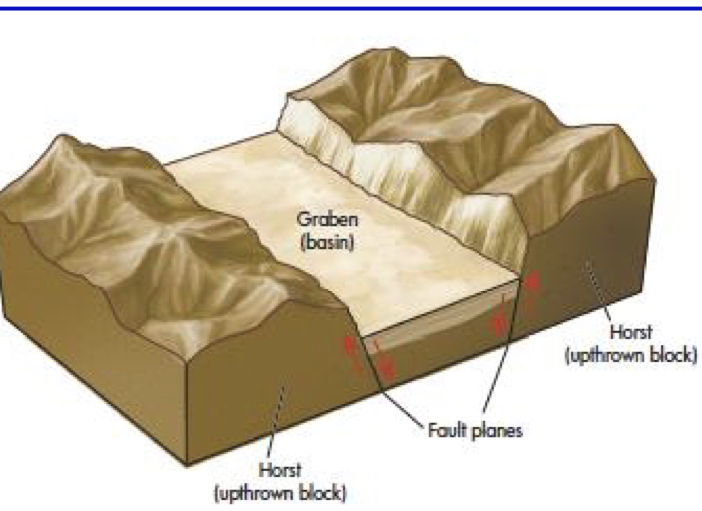
Example of Graben in Canada ?
Ottawa-Bonnechere Graben has two faults, pulling apart, causing the land to sink in the middle
Causes earthquakes
What earthquake related disaster happened in 2011?
Great east japan earthquake
9.0 magnitude earthquake, most powerful ever recorded in japan
Tsunami 33 feet high
Hit Sendai (10m)
Damage from 2011 japan earthquake ?
Destroyed coastal towns and villages, carried ships inland, flattened thousands of homes, then washed tons of debris and vehicles back out to sea
Damage to the reactors at TEPCO’s Fukushima Daiichi Nuclear Power Plant
Contaminated a wide area that still forced around 100,000 residents to evacuate
Around 16,000 died
What’s a volcano?
A mountain or large hill containing a conduit that extends down into the upper mantle, through which magma, ash, and gases are periodically ejected
Active volcanoes ?
Have erupted in the last 10,000 years and could erupt again
BUT Yellowstone hasn’t erupted in 600 000 years but the magma is still hot and moving so it might again
What indicated activeness ?
Magma or hydrothermal properties
Dormant volcanoes ?
Not erupted in the last 10,000 years or more but could erupt again
Extinct volcanoes ?
Have not erupted for tens of thousands of years and can never erupt again
Extrusive volcanism ?
Magma expelled while molten (lava)
Intrusive volcanism ?
Magma solidifies in shallow crust near the surface
Plutonic activity ?
Magma solidifies beneath the surface
Pyroclastic material ?
Solid material that comes out volcano
Solid rock fragments, dust, ash, and lava bombs thrown in air by explosions
The ring of fire is also called ?
Circum-Pacific Belt / Andesite line
What is the ring of fire ?
Plate boundaries exist all around the pacific rim
Primarily subduction zones
Around 75% of all volcanoes lie in the ring of fire
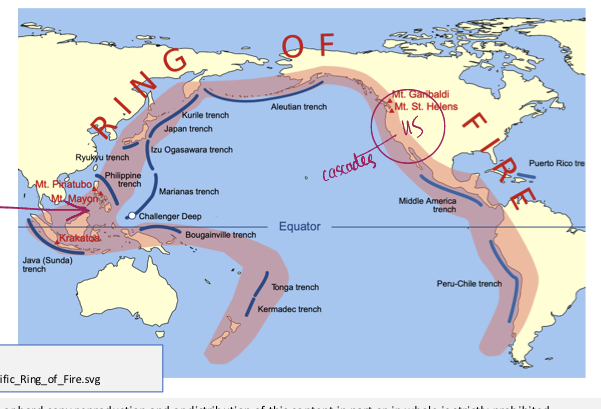
Something high silica is called …
Felsic
Low silica is called …
Mafic
Result of high silica eruptions ?
Thick sticky (high viscosity) and violent eruption
Associated with composite volcanoes and lava domes (rhyolite)
Blow themselves up and collapse because highly explosive because bubbles of gas are trapped in thick magma and pressure builds up
Intermediate silica eruptions ?
Intermediate viscosity magma, explosive eruptions traps quite a bit of gas but not as much that it blows itself up
Composite volcanoes (andesite)
Low silica eruptions ?
Mafic eruptions
Thin runny magma (low viscosity), quiet, non-explosive eruptions
Associated with shield volcanos (basalt)
Know this chart:
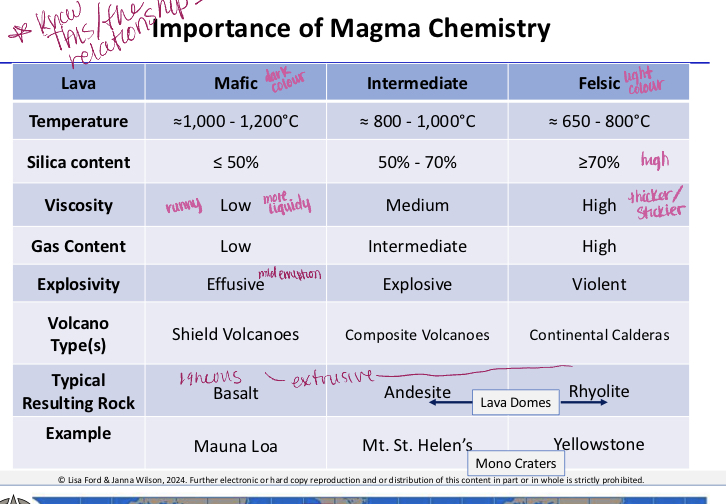
Types of explosive volcano ?
Cinder cone volcano
Composite / stratovolcanos (synonyms)
Cinder cone volcanoes
Form very quickly following a single eruption
Generally found near other volcanoes
Steep sided
Consist of solidified fragments, rock debris, and ash (pyroclasts) that are ejected from a central vent
Highly erodible slopes (erode over a shorter amount of time)
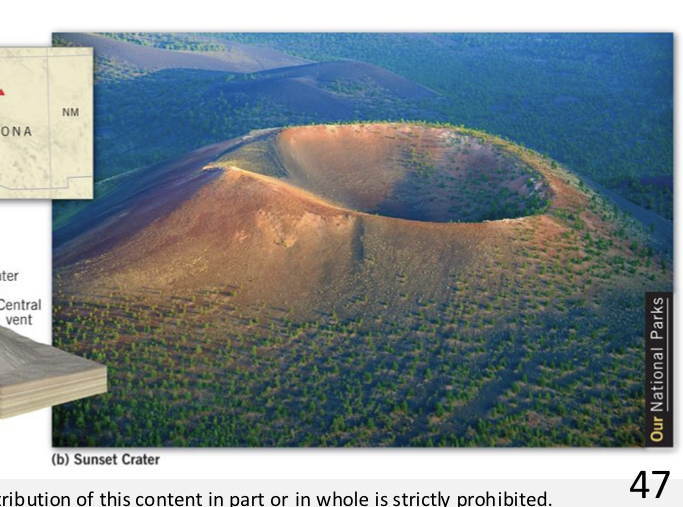
Composite / stratovolcanoes
Very violent eruptions
Made of alternate levels of high silica levels (andesite lava)
Lava is viscous : it cools and hardens before spreading far
The viscous lava traps gases & builds up pressure
Alternates lava & pyroclastic layers
Danger from pyroclastic flow
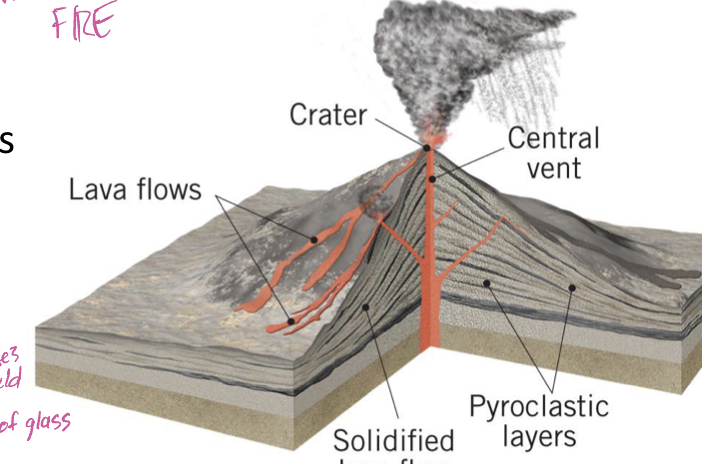
Which type are found in the ring of fire ?
Composite / stratovolcanoes